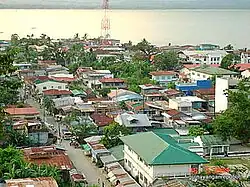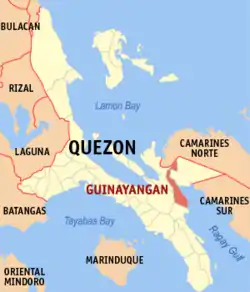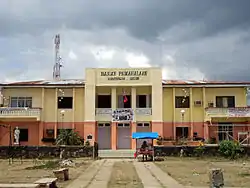Guinayangan | |
|---|---|
| Municipality of Guinayangan | |
 Hilltop view of the municipality | |
 Flag  Seal | |
 Map of Quezon with Guinayangan highlighted | |
OpenStreetMap | |
.svg.png.webp) Guinayangan Location within the Philippines | |
| Coordinates: 13°54′N 122°27′E / 13.9°N 122.45°E | |
| Country | Philippines |
| Region | Calabarzon |
| Province | Quezon |
| District | 4th district |
| Founded | June 21, 1845 |
| Barangays | 54 (see Barangays) |
| Government | |
| • Type | Sangguniang Bayan |
| • Mayor | Maria Marieden M. Isaac |
| • Vice Mayor | Norman D. Dublois |
| • Representative | Keith Micah DL. Tan |
| • Municipal Council | Members |
| • Electorate | 28,269 voters (2022) |
| Area | |
| • Total | 214.12 km2 (82.67 sq mi) |
| Elevation | 71 m (233 ft) |
| Highest elevation | 302 m (991 ft) |
| Lowest elevation | 0 m (0 ft) |
| Population (2020 census)[3] | |
| • Total | 44,045 |
| • Density | 210/km2 (530/sq mi) |
| • Households | 11,521 |
| Demonym | Guinayanganin |
| Economy | |
| • Income class | 3rd municipal income class |
| • Poverty incidence | 17.04 |
| • Revenue | ₱ 172 million (2020) |
| • Assets | ₱ 580.9 million (2020) |
| • Expenditure | ₱ 141.6 million (2020) |
| • Liabilities | ₱ 359.4 million (2020) |
| Service provider | |
| • Electricity | Quezon 1 Electric Cooperative (QUEZELCO 1) |
| • Water | Guinayangan Water District |
| Time zone | UTC+8 (PST) |
| ZIP code | 4319 |
| PSGC | |
| IDD : area code | +63 (0)42 |
| Native languages | Tagalog |
| Website | www |
Guinayangan, officially the Municipality of Guinayangan (Tagalog: Bayan ng Guinayangan), is a 3rd class municipality in the province of Quezon, Philippines. According to the 2020 census, it has a population of 44,045 people.[3]
The name of Guinayangan comes from "gayang", a native word for cane. Its people pronounce it "Ginyangan" omitting the "a" sound.
The municipality is home to the Maulawin Spring Protected Landscape and the critically endangered Inagta Lopez, a dialect of the critically endangered Inagta Alabat language, which has at most 30 speakers left in the world.
History
Guinayangan gained its territory with the transfer of the barrio Aloneros from Tagkawayan by virtue of Executive Order No. 78, signed by President Manuel Roxas on August 12, 1947. The annexation became effective on January 1, 1948.[5]
Geography
Barangays
Guinayangan is politically subdivided into 54 barangays. Each barangay consists of puroks and some have sitios.
- A. Mabini
- Aloneros
- Arbismen
- Bagong Silang
- Balinarin
- Bukal Maligaya
- Cabibihan
- Cabong Norte
- Cabong Sur
- Calimpak
- Capuluan Central
- Capuluan Tulon
- Dancalan Caimawan
- Dancalan Central
- Danlagan Batis
- Danlagan Cabayao
- Danlagan Central
- Danlagan Reserva
- Del Rosario
- Dungawan Central
- Dungawan Paalyunan
- Dungawan Pantay
- Ermita
- Gapas
- Himbubulo Este
- Himbubulo Weste
- Hinabaan
- Ligpit Bantayan
- Lubigan
- Magallanes
- Magsaysay
- Manggagawa
- Manggalang
- Manlayo
- Poblacion
- Salacan
- San Antonio
- San Isidro
- San Jose
- San Lorenzo
- San Luis I
- San Luis II
- San Miguel
- San Pedro I
- San Pedro II
- San Roque
- Santa Cruz
- Santa Maria
- Santa Teresita
- Sintones
- Sisi
- Tikay
- Triumpo
- Villa Hiwasayan
Climate
| Climate data for Guinayangan, Quezon | |||||||||||||
|---|---|---|---|---|---|---|---|---|---|---|---|---|---|
| Month | Jan | Feb | Mar | Apr | May | Jun | Jul | Aug | Sep | Oct | Nov | Dec | Year |
| Mean daily maximum °C (°F) | 26 (79) |
27 (81) |
28 (82) |
31 (88) |
31 (88) |
30 (86) |
29 (84) |
29 (84) |
29 (84) |
28 (82) |
28 (82) |
27 (81) |
29 (83) |
| Mean daily minimum °C (°F) | 22 (72) |
22 (72) |
22 (72) |
23 (73) |
24 (75) |
24 (75) |
24 (75) |
24 (75) |
24 (75) |
24 (75) |
23 (73) |
23 (73) |
23 (74) |
| Average precipitation mm (inches) | 51 (2.0) |
35 (1.4) |
37 (1.5) |
39 (1.5) |
91 (3.6) |
131 (5.2) |
168 (6.6) |
132 (5.2) |
162 (6.4) |
184 (7.2) |
166 (6.5) |
101 (4.0) |
1,297 (51.1) |
| Average rainy days | 13.4 | 10.5 | 11.8 | 12.0 | 19.8 | 24.1 | 26.7 | 25.1 | 25.3 | 23.9 | 21.2 | 17.6 | 231.4 |
| Source: Meteoblue[6] | |||||||||||||
Demographics
| Year | Pop. | ±% p.a. |
|---|---|---|
| 1903 | 3,870 | — |
| 1918 | 4,053 | +0.31% |
| 1939 | 15,948 | +6.74% |
| 1948 | 8,390 | −6.89% |
| 1960 | 16,428 | +5.76% |
| 1970 | 26,278 | +4.80% |
| 1975 | 26,860 | +0.44% |
| 1980 | 29,174 | +1.67% |
| 1990 | 32,829 | +1.19% |
| 1995 | 36,775 | +2.15% |
| 2000 | 37,164 | +0.23% |
| 2007 | 39,074 | +0.69% |
| 2010 | 41,669 | +2.37% |
| 2015 | 45,155 | +1.54% |
| 2020 | 44,045 | −0.49% |
| Source: Philippine Statistics Authority[7][8][9][10] | ||
Economy
Culture
Festivals

When the month of June comes, the people of Guinayangan, Quezon prepare for the annual celebration of Gayang Festival, wherein the coconut tree and the banana is the main attraction of the festivities. The festival is highlighted by a street dancing competition participated by the residents of different barangays, as well as by elementary and high school students.
In the later part of 2000, the very first Seafoods Festival was held in the town. However, it was replaced by Gayang Festival in the succeeding years to give importance to the town's history.
Tourism
- Maulawin Spring Protected Landscape
- Hinabaan Falls
- YumiYami Farm and Resort
- Salacan Resort
- Guinayangan Mangrove Boardwalk
- L.A.C Resort & Leisure Farm
- La Playa Merced
- Villa Leonora Beach Resort
- White House
- Guinayangan Highlands/Magsaysay Hills
- Palad Island
- Tabayigan Falls
- Tabayigan Natural Rock Formation
- Lumot Falls
- Malapinggan Falls
- Busay, Barangay Himbubulo Weste
- Dungawan Falls
- Mangalang Falls
- Dumagundong Falls
- Banot Falls
- Malituko Caves
- Libis Falls
- Busay, Balinarin
- Hillside Resort Balinarin
- D' Pasigan
- Paresan sa Niyugan
Education
- Elementary schools
- Guinayangan Elementary School
- St. Aloysius Gonzaga Parochial School
- Don Guillermo Elementary School
- Gregorio M. Mendoza Elementary School
- Sisi Primary School
- Gapas Elementary School
- Aloneros Elementary School
- Danlagan Elementary School
- Sta. Cruz Elementary School
- San Roque Elementary School
- Dancalan Central Elementary School
- Dancalan Caimawan Elementary School
- Lubigan Elementary School
- Arbismen Elementary School
- Sintones Elementary School
- Capuluan Tulon Elementary School
- Nabangka Elementary School
- San Isidro Elementary School
- Ligpit Bantayan Elementary School
- A. Mabini Elementary School
- Sta. Maria Primary School
- Bagong Silang Elementary School
- San Luis I Primary School
- San Luis II Elementary School
- Dungawan Central Elementary School
- Dungawan Paalyunan Elementary School
- Secondary schools
- Dungawan National High School
- Guinayangan Academy
- Guinayangan National High School
- Sta Cruz National High School
- Lamon Bay SOF - Ext. (Aloneros, Guinayangan)
- Nabangka National High School
- Aloneros National High School
- Saint Aloysius Gonzaga Parochial High School
- Tertiary schools
- Guinayangan Institute Of Technology (Permanently Closed)
- G-sisters Learning Institute of Technology (Permanently Closed)
- Guinayangan College Foundation Inc. GCFI
References
- ↑ Municipality of Guinayangan | (DILG)
- ↑ "2015 Census of Population, Report No. 3 – Population, Land Area, and Population Density" (PDF). Philippine Statistics Authority. Quezon City, Philippines. August 2016. ISSN 0117-1453. Archived (PDF) from the original on May 25, 2021. Retrieved July 16, 2021.
- 1 2 Census of Population (2020). "Region IV-A (Calabarzon)". Total Population by Province, City, Municipality and Barangay. Philippine Statistics Authority. Retrieved 8 July 2021.
- ↑ "PSA Releases the 2018 Municipal and City Level Poverty Estimates". Philippine Statistics Authority. 15 December 2021. Retrieved 22 January 2022.
- ↑ "Executive Order No. 78, s. 1947". Official Gazette (Philippines). Government of the Philippines. August 12, 1947. Retrieved March 20, 2023.
- ↑ "Guinayangan: Average Temperatures and Rainfall". Meteoblue. Retrieved 27 January 2020.
- ↑ Census of Population (2015). "Region IV-A (Calabarzon)". Total Population by Province, City, Municipality and Barangay. Philippine Statistics Authority. Retrieved 20 June 2016.
- ↑ Census of Population and Housing (2010). "Region IV-A (Calabarzon)" (PDF). Total Population by Province, City, Municipality and Barangay. National Statistics Office. Retrieved 29 June 2016.
- ↑ Censuses of Population (1903–2007). "Region IV-A (Calabarzon)". Table 1. Population Enumerated in Various Censuses by Province/Highly Urbanized City: 1903 to 2007. National Statistics Office.
{{cite encyclopedia}}: CS1 maint: numeric names: authors list (link) - ↑ "Province of Quezon". Municipality Population Data. Local Water Utilities Administration Research Division. Retrieved 17 December 2016.
- ↑ "Poverty incidence (PI):". Philippine Statistics Authority. Retrieved December 28, 2020.
- ↑ "Estimation of Local Poverty in the Philippines" (PDF). Philippine Statistics Authority. 29 November 2005.
- ↑ "2003 City and Municipal Level Poverty Estimates" (PDF). Philippine Statistics Authority. 23 March 2009.
- ↑ "City and Municipal Level Poverty Estimates; 2006 and 2009" (PDF). Philippine Statistics Authority. 3 August 2012.
- ↑ "2012 Municipal and City Level Poverty Estimates" (PDF). Philippine Statistics Authority. 31 May 2016.
- ↑ "Municipal and City Level Small Area Poverty Estimates; 2009, 2012 and 2015". Philippine Statistics Authority. 10 July 2019.
- ↑ "PSA Releases the 2018 Municipal and City Level Poverty Estimates". Philippine Statistics Authority. 15 December 2021. Retrieved 22 January 2022.